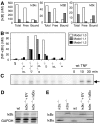A homeostatic model of IkappaB metabolism to control constitutive NF-kappaB activity
- PMID: 17486138
- PMCID: PMC2673708
- DOI: 10.1038/msb4100148
A homeostatic model of IkappaB metabolism to control constitutive NF-kappaB activity
Abstract
Cellular signal transduction pathways are usually studied following administration of an external stimulus. However, disease-associated aberrant activity of the pathway is often due to misregulation of the equilibrium state. The transcription factor NF-kappaB is typically described as being held inactive in the cytoplasm by binding its inhibitor, IkappaB, until an external stimulus triggers IkappaB degradation through an IkappaB kinase-dependent degradation pathway. Combining genetic, biochemical, and computational tools, we investigate steady-state regulation of the NF-kappaB signaling module and its impact on stimulus responsiveness. We present newly measured in vivo degradation rate constants for NF-kappaB-bound and -unbound IkappaB proteins that are critical for accurate computational predictions of steady-state IkappaB protein levels and basal NF-kappaB activity. Simulations reveal a homeostatic NF-kappaB signaling module in which differential degradation rates of free and bound pools of IkappaB represent a novel cross-regulation mechanism that imparts functional robustness to the signaling module.
Figures



References
-
- Alvarez-Castelao B, Castano JG (2005) Mechanism of direct degradation of IkappaBalpha by 20S proteasome. FEBS Lett 579: 4797–4802 - PubMed
-
- Bren GD, Pennington KN, Paya CV (2000) PKC-zeta-associated CK2 participates in the turnover of free IkappaBalpha. J Mol Biol 297: 1245–1258 - PubMed
-
- Brivanlou AH, Darnell JE Jr (2002) Signal transduction and the control of gene expression. Science 295: 813–818 - PubMed
-
- Ghosh S, May MJ, Kopp EB (1998) NF-kappa B and Rel proteins: evolutionarily conserved mediators of immune responses. Annu Rev Immunol 16: 225–260 - PubMed
-
- Hoffmann A, Baltimore D (2006) Circuitry of nuclear factor kappaB signaling. Immunol Rev 210: 171–186 - PubMed

